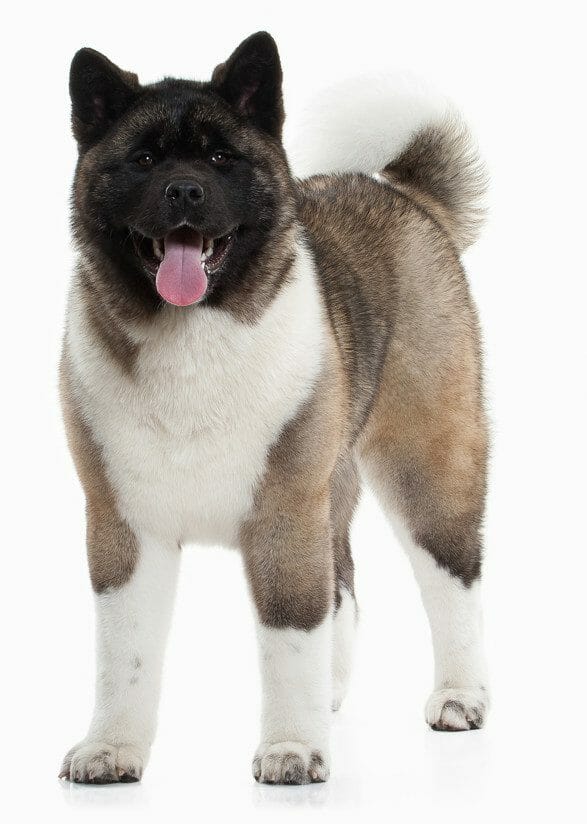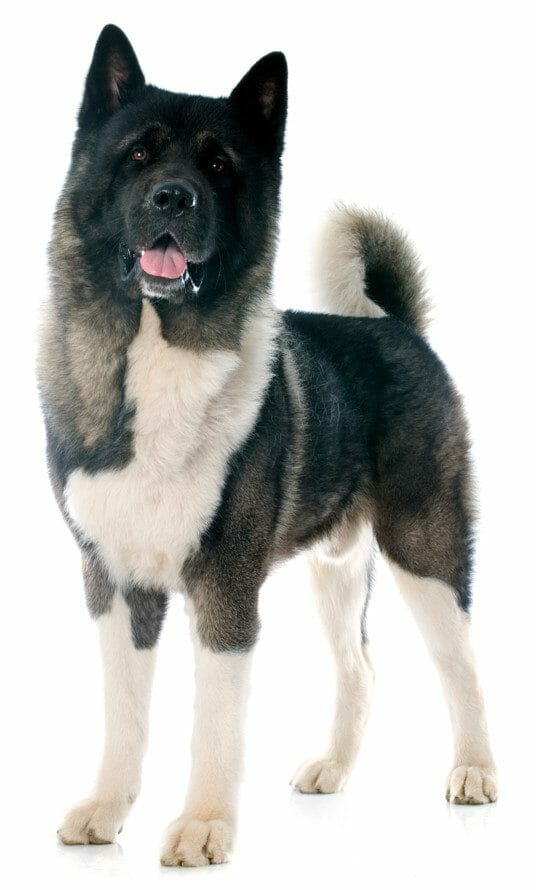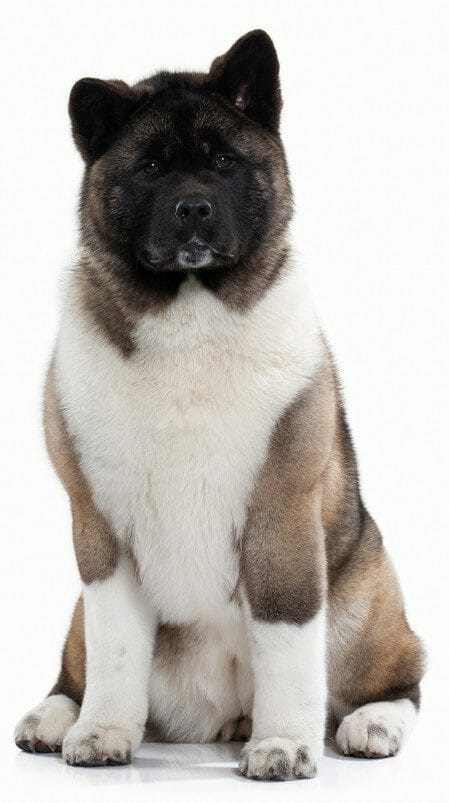Akita

What Is an Akita Dog?
The Akita is a large Japanese dog, of which there are two types: the Akita Inu (or Japanese Akita) and the American Akita. These powerful animals have a strong physical presence and have long been used as guard dogs by the nobility.
Known for its independence, dominance, and loyalty, this breed can be quite affectionate and loving at times. Similar in appearance to many spitz breeds, the Akita has a short double coat of fur much like the Siberian Husky.

What Does an Akita Dog Look Like?
Akitas stand between 24 and 28 inches tall and can weigh up to 110 pounds. They have wide heads, small eyes, erect ears, and short muzzles. Their muscular body is covered with a short, dense coat with a softer undercoat. The legs are straight. The tail is large and curly and is carried high above the dog’s back.
Akita Dog Colors
The breed’s coat colors include:
- White
- Brindle
- Pinto

Akita Dog Personality
Bred to work alone or in pairs, the Akita is happy to be the only pet in the household. If proper socialization is not provided early on, aggression towards strange dogs may occur. Always enroll an Akita puppy in a training class to familiarize them with preferred behaviors.
Due to its size, these dogs
can be difficult to handle. Confident communication is essential, and full training using positive reinforcement techniques should be provided from the day the dog is taken home.

Akita Dog History
The Akita Inu originates from Odate in the snowy mountains of the Akita Prefecture in Japan. Bred since the 16th century, the Akita has served many roles. Between the 1500s and 1800s, they were companions to samurai warriors. They have worked as guard dogs for royalty and noblemen in feudal times. Throughout the 1600s, they were used in dogfighting. They were also used to hunt large animals such as boar, bears, and elk.
The breed was in decline by the 20th century, and crossbreeding became more frequent. St. Bernards, German Shepherds, and Mastiffs were all interbred with Akitas, which means many of the dogs lost their spitz appearance.
The look of the Akita was restored by mixing it with native Japanese dogs breeds such as Matagi and Hokkaido Inu. Modern Akitas share few genetic similarities with the western breeds following the breed’s reconstruction. However, this is not true of the American Akita as these dogs retained their western genetics.
In the 1920s, an Akita called Hachikō became world-famous. Hachikō would walk with his owner to and from the train station each day. Every day, the dog would await the return of his master’s train. Unfortunately, his owner died of a brain hemorrhage one day at work. From that day, Hachikō continued to return to the train station to wait for his owner for the remainder of his life. In 2009, the story was adapted into a movie called “Hachi: A Dog’s Tale.”

The Akita Inu Hozonkai was initiated to preserve the breed, and in 1931 the Akita was declared a Japanese natural monument. Three years later, the official breed standard for the Akita was written.
Throughout the Russo-Japanese War, Akitas were used to great effect to find missing sailors and track prisoners of war. During World War II, a government order insisted that all non-military dogs should be culled. To circumvent this rule, breeders began creating the Akita-German Shepherd mix.
Following the war, the Akita began to thrive again in occupied Japan. Efforts to preserve the breed were made, and the dogs were regularly shown. When the occupying U.S servicemen returned home, many took Akitas with them.

Akita Health Issues
Although the breed is usually healthy, owners need to be aware of several genetic conditions that could affect their Akita.
- Hip Dysplasia. As a larger breed, Akitas can be prone to hip dysplasia. While still growing, the two halves of the hip joint can begin to develop abnormally. This causes pain and discomfort when moving the joint and can lead to lameness and arthritis. A veterinarian will conduct an X-ray to diagnose the condition, and it can be treated using non-steroidal anti-inflammatory drugs, glucosamine, omega-3 supplements, physiotherapy, and surgery.
- Gastric dilatation-volvulus. Often referred to as bloat, this potentially fatal condition occurs when the stomach becomes distended and twists. Usually, the condition occurs if a dog eats a meal quickly and then exercises immediately after. Signs that immediate veterinary assistance is needed include restlessness, distended abdomen, lethargy, confusion, retching, and excessive salivation. If it is not treated quickly, this condition can cause death.
- Hypothyroidism. This condition affects thyroid production. An underactive thyroid will slow the dog’s metabolism down, causing weight gain, skin and hair conditions, high cholesterol levels, and lethargy. Treatment for hypothyroidism involves using an oral synthetic thyroid hormone replacement.
- Progressive retinal atrophy (PRA). Abnormal developments in the eyes can cause PRA, a condition that will cause nighttime blindness in young dogs and will progress to full-blown blindness over time. There is currently no effective treatment for PRA.
- Sebaceous adenitis (SA). This genetic autoimmune disorder affects the skin and can easily be mistaken for an allergy. The sebaceous glands in the dog’s skin will become inflamed and will gradually be destroyed. Ordinarily, these glands would produce sebum, the purpose of which is to stop the skin from drying out. The condition can cause hair loss and the skin will become thick and scaly. A veterinarian will carry out a skin biopsy, and treatment may involve the use of anti-seborrheic shampoo, dietary supplements, and immunosuppressant therapy.
Akita Adoption
Before looking to buy an Akita Inu, it is always a good idea to check animal shelters. Often, owners will either underestimate the commitment involved in owning an Akita or face a change of personal circumstances, and many dogs are given up for adoption. Always find a no-kill shelter that has strict policies to never euthanize a healthy animal.
Before taking in Akita Inu puppies for adoption, consider how they will be socialized and trained. While this breed is generally friendly, it can be headstrong and difficult to handle when training has not been provided.

